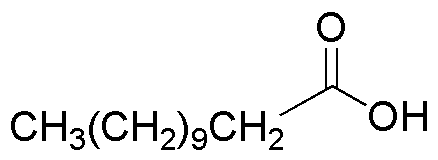Lauric acid is widely utilized in research focused on:
- Cosmetics and Personal Care: This fatty acid is a key ingredient in many skincare products due to its moisturizing properties. It helps to improve skin hydration and can enhance the texture of creams and lotions.
- Food Industry: Lauric acid is found in coconut oil and palm kernel oil, making it valuable in food production. It is used as a flavoring agent and can also serve as a preservative due to its antimicrobial properties.
- Pharmaceuticals: In drug formulation, lauric acid is used as a surfactant and emulsifier, aiding in the delivery of active ingredients. Its ability to enhance the solubility of certain compounds makes it beneficial in developing effective medications.
- Biodegradable Surfactants: This compound is used in the production of eco-friendly surfactants, which are less harmful to the environment compared to traditional petrochemical-based surfactants, making it a preferred choice for sustainable products.
- Industrial Applications: Lauric acid is utilized in the production of soaps and detergents, where it contributes to the cleaning power and lathering ability of these products, offering a natural alternative to synthetic ingredients.
General Information
Properties
Safety and Regulations
Applications
Lauric acid is widely utilized in research focused on:
- Cosmetics and Personal Care: This fatty acid is a key ingredient in many skincare products due to its moisturizing properties. It helps to improve skin hydration and can enhance the texture of creams and lotions.
- Food Industry: Lauric acid is found in coconut oil and palm kernel oil, making it valuable in food production. It is used as a flavoring agent and can also serve as a preservative due to its antimicrobial properties.
- Pharmaceuticals: In drug formulation, lauric acid is used as a surfactant and emulsifier, aiding in the delivery of active ingredients. Its ability to enhance the solubility of certain compounds makes it beneficial in developing effective medications.
- Biodegradable Surfactants: This compound is used in the production of eco-friendly surfactants, which are less harmful to the environment compared to traditional petrochemical-based surfactants, making it a preferred choice for sustainable products.
- Industrial Applications: Lauric acid is utilized in the production of soaps and detergents, where it contributes to the cleaning power and lathering ability of these products, offering a natural alternative to synthetic ingredients.
Documents
Safety Data Sheets (SDS)
The SDS provides comprehensive safety information on handling, storage, and disposal of the product.
Product Specification (PS)
The PS provides a comprehensive breakdown of the product’s properties, including chemical composition, physical state, purity, and storage requirements. It also details acceptable quality ranges and the product's intended applications.
Certificates of Analysis (COA)
Search for Certificates of Analysis (COA) by entering the products Lot Number. Lot and Batch Numbers can be found on a product’s label following the words ‘Lot’ or ‘Batch’.
*Catalog Number
*Lot Number
Certificates Of Origin (COO)
This COO confirms the country where the product was manufactured, and also details the materials and components used in it and whether it is derived from natural, synthetic, or other specific sources. This certificate may be required for customs, trade, and regulatory compliance.
*Catalog Number
*Lot Number
Safety Data Sheets (SDS)
The SDS provides comprehensive safety information on handling, storage, and disposal of the product.
DownloadProduct Specification (PS)
The PS provides a comprehensive breakdown of the product’s properties, including chemical composition, physical state, purity, and storage requirements. It also details acceptable quality ranges and the product's intended applications.
DownloadCertificates of Analysis (COA)
Search for Certificates of Analysis (COA) by entering the products Lot Number. Lot and Batch Numbers can be found on a product’s label following the words ‘Lot’ or ‘Batch’.
*Catalog Number
*Lot Number
Certificates Of Origin (COO)
This COO confirms the country where the product was manufactured, and also details the materials and components used in it and whether it is derived from natural, synthetic, or other specific sources. This certificate may be required for customs, trade, and regulatory compliance.

